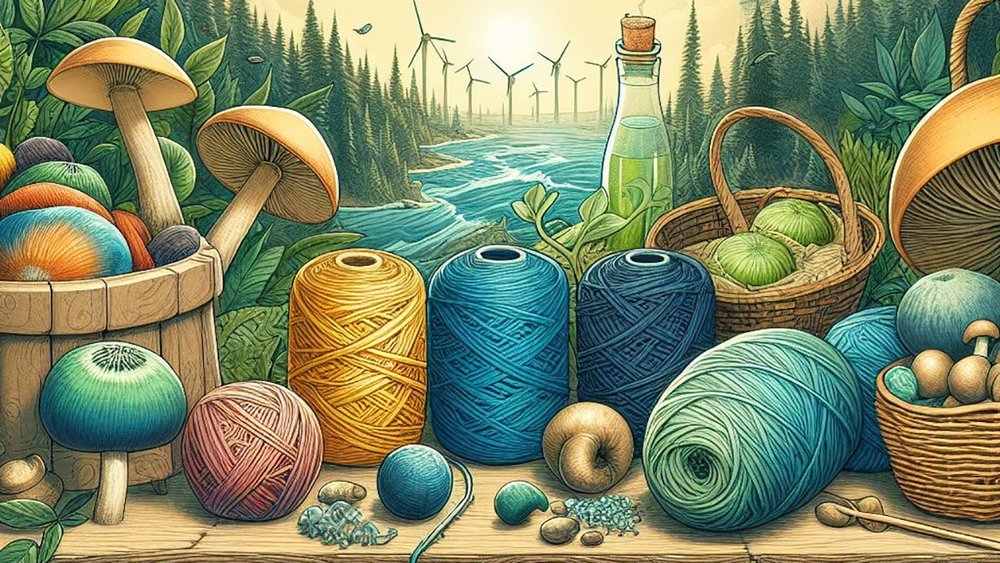
For decades, the fashion industry has been synonymous with excess and environmental damage. From the mountains of discarded clothing ending up in landfills to the harmful practices used to produce fabrics, the impact on our planet has been undeniable. But a revolution is brewing, fueled by a growing awareness and a surge of innovative, eco-friendly textiles that are changing the game. Let’s dive into this exciting world and explore the questions shaping the future of sustainable fashion:
Can clothes be made from recycled plastic?
Absolutely! Brands like Patagonia and The North Face are incorporating recycled plastic bottles into their collections, creating durable and stylish jackets, fleeces, and even swimwear. This innovative process helps reduce plastic waste while offering a practical and often more affordable alternative to virgin materials.
What are the benefits of mushroom leather?
Mushroom leather, also known as mycelium leather, is a groundbreaking material made from the root-like network of fungi called mycelium. It boasts a remarkable range of benefits:
Sustainable growth: Mycelium requires minimal resources like water and land, and its production process doesn’t generate harmful chemicals or greenhouse gases.
Biodegradable: Unlike traditional leather, mushroom leather naturally decomposes at the end of its lifespan, minimizing its environmental footprint.
Versatility: From supple textures resembling genuine leather to sturdy options for bags and shoes, this material offers a wide range of possibilities for designers.
How can I shop for more sustainable clothing?
The good news is, there are more ways than ever to make conscious clothing choices! Here are some tips:
Support brands with transparent and ethical practices: Look for brands that disclose their supply chains, use recycled materials, and advocate for fair labor conditions. Certifications like GOTS and Fairtrade can be helpful indicators.
Embrace secondhand and vintage: Give pre-loved clothes a new lease on life by shopping at thrift stores, online platforms, or clothing swaps. This reduces demand for new clothing production and extends the lifespan of existing garments.
Invest in quality over quantity: Opt for well-made pieces from durable fabrics that will last longer, reducing your need to buy new clothes frequently.
Care for your clothes properly: Washing clothes less often and using eco-friendly detergents can significantly reduce their environmental impact.
What are the biggest challenges facing the sustainable fashion industry?
Despite the progress made, several challenges remain:
Greenwashing: Unfortunately, some brands engage in misleading marketing practices, making it difficult for consumers to identify truly sustainable options.
Cost and accessibility: Sustainable materials and production methods can be more expensive, limiting accessibility for some consumers.
Lack of infrastructure: Recycling and circular economy systems for textiles are still developing in many parts of the world.
What is the future of eco-friendly textiles?
The future of fashion is bright, with exciting innovations emerging all the time. Here’s a glimpse into what’s to come:
Bio-based fabrics: Utilizing renewable resources like algae, bamboo, and even orange peels to create sustainable alternatives to traditional fibers is a promising area of research.
Circular economy models: Renting and leasing clothing, repairing and upcycling existing garments, and designing for disassembly are gaining traction, minimizing waste and maximizing resource utilization.
Advanced recycling technologies: New methods are being developed to break down complex materials like polyester into their basic building blocks, enabling them to be recycled infinitely.
What technologies are revolutionizing the way clothes are made?
Technology is playing a crucial role in driving sustainable innovation:
3D printing: This technology allows for on-demand production, reducing waste and enabling customization, potentially leading to more mindful consumption.
Digital design and manufacturing: Advanced software tools are optimizing production processes, minimizing material waste and energy consumption.
Blockchain technology: This can ensure transparency in supply chains, preventing unethical practices and promoting responsible sourcing.
How can I reduce my own fashion footprint?
Every individual can contribute to a more sustainable fashion future. Here are some actions you can take:
Challenge your buying habits: Ask yourself if you truly need a new item before purchasing. Consider borrowing or renting clothes for occasional wear.
Extend the life of your clothes: Wash them less often, mend any damage promptly, and learn basic clothing care techniques.
Support sustainable brands: Do your research and choose brands that align with your values.
Spread awareness: Talk to friends and family about sustainable fashion, encouraging them to make conscious choices.
Are there any government incentives for buying sustainable clothing?
While widespread government incentives for sustainable fashion are still emerging, certain initiatives are encouraging progress:
Tax breaks and subsidies: Some countries offer tax breaks for businesses that use recycled materials or implement sustainable practices. In some cases, consumers may also benefit from tax deductions for purchasing sustainable clothing.
Extended producer responsibility (EPR) schemes: These programs place the responsibility for end-of-life management of products on manufacturers, incentivizing them to design for recyclability and durability.
Public awareness campaigns: Governments are increasingly launching campaigns to educate consumers about the environmental impact of fashion and encourage them to make sustainable choices.
What are the ethical considerations when buying clothes?
Beyond environmental impact, ethical considerations are crucial in sustainable fashion:
Fair labor practices: Ensure the clothes you buy are made by workers receiving fair wages and working in safe and healthy conditions. Look for certifications like Fairtrade or SA8000.
Transparency in supply chains: Brands that clearly disclose their production processes and sourcing locations are more likely to be operating ethically.
Animal welfare: If you choose natural fibers like wool or leather, opt for options sourced from farms that prioritize animal welfare.
Conclusion:
The rise of sustainable fabrics and innovative technologies marks a pivotal shift in the fashion industry. It’s a journey requiring collaboration between consumers, brands, and policymakers. By making informed choices, supporting ethical and sustainable practices, and embracing innovation, we can rewrite the narrative of fashion, ensuring a future where style and sustainability go hand in hand. Remember, every conscious decision, every thread woven with a commitment to our planet, contributes to a more responsible and beautiful future for fashion.
Leave a Reply